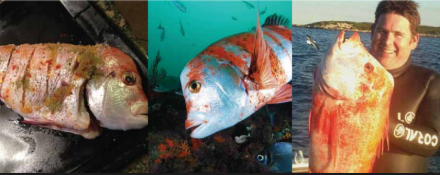
Chrysoblephellus Gibbiceps, Red Stump and Miss Lucy are the names given to the fish that most spearos simply call a Stump (or Stomp, if you belong to the Hugenote club!) I recently read a report stating that a 4.5kg Red Stump is estimated to be 47 years old. It’s amazing how slow growing this species is, and as a result is susceptible to overfishing. This common reef species has been put on MCM’s critical list and the SASSI red list. You are advised not to buy it or order it in restaurants, despite it still being commercially exploited without restriction. The recreational daily quota was cut to one fish per day in a weak attempt to alleviate pressure on the species.
Stumps tend to favour depths of 16 metres and deeper. I’ve heard of commercial fishermen catching them in water as deep as 100 metres off the banks of Tsitsikamma. After a day or two of strong easterly winds in the Summer, the icy thermoclines push Stumps into shallow reef areas and it’s on these days that the divers who don’t normally dive exceptionally deep can spear them.
Red Stumps seem to congregate in big shoals at certain times of the year, usually between December and February. They also seem to swim aggressively in shoals when the weather is stormy.
The relationship between lightning and aggressive behaviour probably has something to do with a drop in barometric pressure, preceeding a cold front. I believe that this triggers a feeding instinct in preparation for bad weather. If you’re lucky enough to stumble upon an area where Stumps congregate, it’s like shooting fish in a barrel. Just remember your bag limit of one per person per day! Too many guys shoot the first Stump they see, only to find that if they had been more patient, they would have gotten a much bigger fish later in the day. Stumps seem to travel in pairs of a male and female fish. The males have big, white protruding foreheads and the females have more of a sloping forehead. So, if you see one that looks a bit small, do a few more dives in the area and try and spot a potentially bigger partner before pulling the trigger.
I’ve seen huge shoals of Stumps in areas like the Garden Route, Arniston and the banks off Struis. The older generation of Cape divers will tell you about the massive shoals of Stumps that moved into False Bay in the Summer months. This is a sight that nobody has seen in the last 20 years and is a sure sign that the species has taken a hammering.
Any spearo will tell you that Stumps are fairly easy to spear, the hardest part is actually locating them! Areas to look for Stumps are usually flat, sandy reefs and pinnacles or ledges that drop onto flat, scattered reef. The two indicators that I look for are; Black Bank Steenbras and the tall orange fans that are found on flat reefs in Eastern Cape bays. Most of the gut content of a Stump consists of red crabs, sea urchins, hermit crabs and worms. As long as you find areas that have this food source, it will only be a matter of time before a Stump comes swimming by.
On the odd occasion, I have used a special technique in getting Stumps to show themselves. I dive down and find a rock on the bottom, which I then rub on the reef to make a grinding noise, or even knock it against another rock. I’m not sure if it’s their curiosity that makes them come in, or if the noise, simulates other Stumps feeding, but it works every time! Once in a while, guys are lucky enough to spear Stumps over the 6kg mark and at the beginning of the year, I got my chance and landed a beautiful 7.1kg fish, this was without a doubt the catch of a lifetime.
So, if you’re in the Eastern Cape this Summer, watch the weather patterns, find the thermoclines and hopefully you’ll find your own big Stump!
